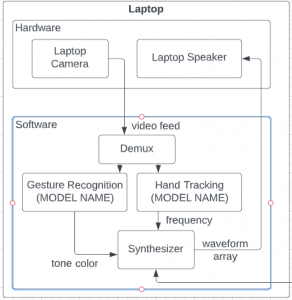- What did you personally accomplish this week on the project? Give files or
photos that demonstrate your progress.
This week I continued to improve on the oscillator program I wrote last week so that it supports mouse-controlled real-time playing. When run, pyautogui will first get the cursor position. If the cursor is on the left side of the screen, the program plays a C4 indefinitely. If the cursor is on the right, the program plays a E4 indefinitely. Here is a short demonstration video of it working.
I spent quite a lot of time fixing the “snaps” when looping clips of a frequency. First I thought it can be fixed by trimming the generated frequency array so that the difference between the first element and the last is relatively small. However, the snap only got a little bit better. I then realized I have to reduce the software overhead (actual gap in time) of repeating a frequency array, so I tried to find a python library that supports looping with the lowest overhead. I have tried packages like pyaudio, simpleaudio, and pymusiclooper. However, since most of these libraries loop a wavfile on an infinite loop, the gap between each repeat is still noticeable. In the end, I used a library called sounddevice that implements looping using callbacks, and since there is virtually no gap between repeats, looping is now unnoticeable.
- Is your progress on schedule or behind? If you are behind, what actions will be
taken to catch up to the project schedule.
I think my progress is on schedule. However, using an existing synthesizer software is always a back up plan. In that case, I only need to figure out how to change parameters through my own program instead of its GUI.
- What deliverables do you hope to complete in the next week?
I plan to add two more functionality to my oscillator program: real-time cursor-based volume control, and real-time vibrato. I plan to implement the vibrato using a envelope that performs amplitude modulation on the generated frequency array.
- Particular ECE courses that covered the “keep it simple” principle
The most important thing I learned last week was to keep everything simple. After experimenting with looping frequency arrays, I found that the library that works the best are the ones that have the fewest lines of code to write. I don’t remember classes that explicitly covered this principle, but it is a theme in most programming courses like 18-213(i.e. keep your code short and simple).

